|
CONSCIOUSNESS AS SOMETHING
All philosophies are mental
fabrications.
There has never been a single doctrin
by which one could enter the true essence of things.
Nargajuna
This spirit knows no time nor number:
number does not exist apart from the malady of time.
Meister Eckhart
After the previous chapters
deconstruction of consciousness and Western pride, it's now time to begin the
hunt for consciousness. Meditation is the pursuit that leads to insight into our
own ignorance of consciousness. However, let me remind myself and the patient
reader: In this hunt for consciousness we will not even get near
to the essential mystery it present. However, we will get a
little nearer by describing more subtle qualia living in closer
proximity to the black hole of consciousness. If our experience
of unknowing does not expand even more, we can be sure we are on
the wrong track.
No monad or triad can
express the all-transcending hiddenness
of the all-transcending superessentially superexisting superdeity.
Pseudo-Dionysius
345 - 407 AD
Perhaps the most frightening aspect of meditation is that introspection can
'unintentionally' reveal our absolute unknowing, and with this unknowing, our
illusion of control over ourselves and the world is removed.
Based on my own experiences with meditation, I will now argue: Only in
relatively 'higher,' intensified states of consciousness can one catch a glimpse
of what consciousness is, and even then, only the aspects of consciousness that
are 'lower' in relation to the 'higher' states. The lowest part of me is my
feet. I will begin there.
Alexander and Buddha
In ancient Buddhist traditions, it was said that the Buddha
did not desire any personal representations. Consequently,
artists were only permitted to depict him indirectly through his
hands or feet. Interestingly, it was the Macedonian Greeks
residing in the long-lost Kingdom of Bactria who, upon
converting to Buddhism, crafted the first Buddha statues.
Accustomed to envisioning gods in human forms like Alexander the
Great, they shaped their Buddha and his perception in a similar
personal manner. This is why Buddha statues to this day are
adorned with Greek himations. The post-Alexandrian Greeks in the
east were pioneers in creating Buddha statues, inadvertently
causing the original message of the primordial invisibility of
the nirvanic realm to be obscured by the compassionate face of
the Buddha.
The Enigmatic Buddha's
Footprints
"For
creatures are only God’s footprint."
Meister Eckhart
In an intriguing sci-fi movie I once watched, a thief
managed to render himself invisible using advanced technology.
Despite his clever tactic, he was eventually caught when the
resourceful detectives laid wet paint on the floor, exposing his
footprints. While consciousness itself remains veiled, its
primordial impact on our reality is evident in the form of
footprints left in time and space. At the heart of individual
and cultural understanding and development lies the invisible
and location-less pillar of consciousness. Civilizations,
groups, and individuals rise and fall with the quality and
intensity of their consciousness and wakefulness.
The Challenging Enigma of the
Eight Ball

Our relationship with
consciousness can be likened to the black eight ball in American
pool. In the game, players aim to pocket all their colored balls
before targeting the eight ball. If the eight ball is
accidentally pocketed before clearing the other balls, the
player loses the game. Hence, there's a saying associated with
the game: "
Always keep an
eye on the eight ball.
By and large, scientists can
explain the world in a mechanistic way, much like describing a
game of pool. However, when it comes to the eight ball of
consciousness, there's a general agreement that consciousness is
qualitatively different from sentient matter. Despite this, many
assume that consciousness, like any other ball, must follow the
mechanistic rules set by time and space. It's a challenging
enigma, but it seems solvable with the right measurements and
algorithms.
In this pursuit, the study of consciousness has shifted from the
realm of priests, mystics, and philosophers to the world of
brain scientists. As a result, the concept of "experience" has
become central to understanding consciousness. The once-daunting
problem of consciousness is now seemingly more approachable, as
experiences can be measured by their correlates in the brain.
Language in Consciousness
Theologicans may quarrel,
but the mystics of the world speak the same language.
Meister Ekchart
When academically trained minds have tried to analyze
mysticism, they have often attempted to encapsulate words and
concepts from various traditions in order to demonstrate the
distance and incompatibility between Eastern and Western
mysticism, and between different mystics themselves. This, in my
opinion, futile effort is a necessary consequence of the
academically trained mind not having had personal consciousness
experiences that could be brought into play. It's not part of
the curriculum. The academic brain overestimates the
significance of the natural differences in mystical experience
that time, geography, and culture create. The academic reality's
fuel is to breed words in a reality that is already overcrowded
with words pointing to even more words in the world of words.
Imagine two competing candidates for a professorship at an
institute. One says with burning eyes and synchronous
theta-alpha-gamma waves in their frontal lobes: Everything is
one. We are all one with the common consciousness. After this
statement, the lecture is over. The other candidate has written
a thesis of several hundred pages pointing out how this or that
spiritual concept is different from another. There's no doubt
who will win in a time like ours, which favors knowledge over
wisdom.
I fondly remember my own time at Aarhus University, where we
critically analyzed Koans and Haiku poems. Of course, some
useful interpretive stuff came out of it, which one could later,
as an adjunct, say something smart in front of a group of high
school students. It just had nothing to do with the almost
explosive expansions of consciousness that at the time allowed
me to laser-like see these foreign poems' interference language
reveal itself intuitively in wonderful holographic teachings.
The fluid equal sign between God, Soul,
Emptiness, and Consciousness
For those who have had personal mystical
experiences, all mystics from all times appear as one trans-historical being
with one transpersonal experience. Differences give way to similarities.
Therefore, I cut a heel and clip a toe and, without hesitation, place a fluid
equal sign between consciousness, soul, emptiness, and God. Jesus' personal love
and Buddha's emptiness are one and the same.
Of course, there are culture- and history-dependent differences when
transpersonal experiences are boiled down into the language soup. For language
is created by individuals and non-transpersonal beings. Words originated as
intersubjective tools that, by the power of the collective, enabled us to
triumph on the savannah. It is difficult with fixed and precisely defined words
to penetrate the abstract dimension beyond the personal. That is why mystics of
all times and places have agreed on the difficulty of describing the mystical
experience.
Therefore, I suffer from my tongue's lack of
words.
What happens within me, I know well,
but I cannot describe it.
The Theologian Simeon
We cannot describe consciousness objectively
solely because the same consciousness is the observer of what is to be observed.
What Gödel proved concerning the axioms of mathematics also applies to the
exploration of consciousness.
God is beyond all names, nothing can express
him.
Meister Eckhart
The innermost essence of the consciousness mystery
is fundamentally impossible to capture in the narrow-spectrum reality of words.
For this reason alone, it is futile to study mysticism from an academic
perspective. However, those who are experienced can thoughtfully attempt to
describe consciousness in images. Words that have recognized their own
limitations can indeed take small digs deeper into the primordial ground.
Therefore, despite their meta-cognitive knowledge of the project's
impossibility, mystics have time and again attempted to give the mystery a
linguistic form. Whether we read the Indian Upanishads, Meister Eckhart's
treatises, the Islamic Sufi anecdotes, the Zen Buddhist koans, or haiku poems,
we will find attempts to describe the mystery that, according to the young
Wittgenstein, one should remain silent about.
Every new research area eventually gives rise to its own
linguistic tool. The Western understanding of consciousness is
currently like a blacksmith trying to repair a smartphone with a
hammer. No blacksmith would be foolish enough to attempt it,
which further puts the image into perspective.
Just as quantum physics had to develop its own linguistic
conceptual universe far from the blacksmith's world, it is
necessary for the exploration of the phenomenon of consciousness
to develop its own language.
In English, the saying goes: It takes ONE to know ONE. The same
must apply to '0': It takes a zero to know a zero. Therefore,
the question is: Can I, as something at all, understand nothing?
Can nothing be described with words? Can 0 be described using
numbers?
I will try to get as close as possible, describe it more
accurately in the same way that I can describe 1000 as 999
without using 0.
Not this - nor that
Following the paradoxical knockout of our verbal control
brain's attempts to understand the great nothing, we see the use
of negation:
God is such that we understand him better through negation
than affirmation.
Meister Eckhart
Buddhism describes Nirvana based on what it is not. Nirvana is
the absence of samsara, of suffering. The Indian Advaita Vedanta
tradition, especially with Adi Shankara, continues this
tradition. Here, consciousness is characterized as:
Neti, neti
Not this, (nor) that
The Indian mystic's description of the highest reality is
reminiscent, even down to the syntax, of that which the best of
the European medieval mystics had. Meister Eckhart says:
But now I say:
It is neither this nor that
Yet it is...
It is free from all names
emptied of all forms
The paradoxical formulation
The paradoxical formulation comes as a natural consequence
of words' inadequacy to stand at the center of attempts to
describe the indescribable. Zen Buddhism's koans and numerous
Sufi stories are built around the paradox.
Here comes one of Eckhart's contrapuntal minimalisms:
If I had a God I could understand,
He would no longer be my God.
From India's wise to the Islamic Sufi tradition, from Zen
Buddhism's koans to the European mystic masters - all are known
for the use of paradoxical statements, where a breakthrough from
reason is achieved by a kind of reductio ad absurdum.
The richness in poverty
To be nothing, to have nothing,
to keep nothing for oneself
is the greatest gift,
the highest generosity.
Nisargadatta Maharaj
All is nothing
In mysticism, there is a long tradition of linguistically
describing the inner experience in the contrast between
everything and nothing.
God, because of His greatness,
rightly should be called Nothing.
Scotus Erigena (800-880)
Seeing nothing, he saw God.
Meister Eckhart
My intellect tells me that I am nothing.
My heart says that I am everything.
Between these two poles, my life flows.
Nisargadatta Maharaj
The luminous darkness
Meister Eckhart was a master in the art of conscious knowing of
unknowing. Hence I let him sum up what I want to say:
God's darkness is his nature which is unknowable.
The intuitive intellect senses, through the poetic
interfaces of language and the cracks opened by the paradox, the
unfathomable luminous darkness of metanoia in consciousness.
The light which is God is flowing and darkening every light.
Meister Eckhart (1260 -1328)
In mysticism, the rich and profound experiences are often
described in the context of contrasts such as everything and
nothing or light and darkness. The language of mysticism seeks
to convey these profound experiences through paradoxes and
metaphors, as words alone cannot capture the essence of these
transcendent experiences.
The
great ZERO and God's non-existence
This
spirit knows no time nor number:
number does not exist apart from the malady of time.
Meister Eckhart
How can one describe nothing?
Precisely as nothing. In this sense, consciousness is nothing,
equal to no thing. Consciousness is not any thing. Therefore, it
is obvious to equate consciousness with ZERO. The mathematical
zero, with its circular beauty, is one of the most suitable
metaphors for the phenomenological emptiness of consciousness.
The history of mathematics itself shows the deep relationship
between the spiritual concept of emptiness and the mathematical
zero. Zero was "discovered" in India, most likely by Indian
Buddhist monks trained in Greek logic, in their attempt to
describe the essential emptiness of the world. This
deconstruction was carried out as a deeply logical mathematical
operation. To this day, zero is called "Shonyo/sunyata" in
Indian, which is the original Buddhist/Hindu Sanskrit term for
the emptiness of existence. To the great annoyance of all
positive sciences, zero is most likely a religious "invention."
In Meister Eckhart's world, numbers and time are sharply
separated from the reality of the spirit. The realm of the soul
is the great nothing:
Divinity is poor, naked, and empty, as if it were not;
it has not, does not want, does not desire, does not work, does
not get....
Divinity is so empty as if it were not.
Meister Eckhart
Zero is
here and nothing is... nowhere and omnipresent.
Therefore, God does not exist. For God is nothing:
God
is the absolute nothing,
which is beyond all existence.
'Pseudo-Dionysius' (345 - 407)
Pseudo-Dionysius provides us with the key to God as the perfect
metaphor for ourselves in our most unfathomable aspect: that is,
nothing in itself.
Things are created from nothing,
therefore their true origin is nothing.
Meister Eckhart
In
mysticism, God and consciousness are often described as nothing
or emptiness. This concept transcends conventional understanding
and language, pointing to a deeper truth that transcends the
limitations of our material existence.
Therefore, you are God
The god or gods we have sought and worshipped through all
the culturally constructed thought forms we have created since
we evolutionarily reached the stage where we could recognize
ourselves as mortal beings are nothing more than pure
projections of our own unfathomably incomprehensible and
immeasurable consciousness.
Of course, we created God in our own image. The big question now
is whether anything useful can come out of it. Meditation.dk
definitely believes YES!
I repeat: Without hesitation, I therefore metaphorically equate
God, Love, Consciousness, and ZERO. God, like Consciousness, is
the pure ZERO. The thinking mind will naturally disagree with me
and claim that there is a big difference between emptiness and
love. However, the thinking mind, if logically consistent, may
come to the same conclusion as me in the following statement:
God does not exist. His existence is like that of zero, a
non-existence.
Consciousness is the nothingness that, in contrast, manifests a
world of things. God is humanity's visionary self-image when the
inner mirror of emptiness reflects itself.
'God' is a first, tentative attempt to describe consciousness in
consciousness. Here, in this projector's lighting, the zero gets
an old man's white beard or is worshiped as a mother goddess
with four arms in a place in the back of India.
Every time we exclaim that God is dead, it is in reality our own
conception of Him that has died. It can be nothing else.
However, every time a religious narrative dies, it will sooner
or later, that is my prophecy, be reborn in a truer and more
beautiful version.
The following quote by Eckhart, I see as a scientific twin to
religious striving:
Man has to
seek God in error and forgetfulness and foolishness.
The idea that each person is God,
or a manifestation of divine consciousness, is found in many
spiritual traditions. This understanding can lead to personal
growth, compassion, and a deeper connection with the world
around us. Embracing the idea that we are all connected to the
divine can help us find meaning, purpose, and fulfillment in our
lives.
The living Mirror of Emptiness
One of the most used metaphors for
consciousness in mysticism is the mirror:
As images are seen in a mirror, so the universe
is an image in the mirror of Consciousness.
Tripura Rahasya XL verse 53-54
The mind is like a reflection in a mirror:
Though it is insubstantial,
it is not nonexistent.
P'ang Yun, Layman P'ang - China
The metaphor of the mirror is a powerful way to
describe consciousness because it captures the idea that consciousness reflects
the world around us, just as a mirror reflects images.
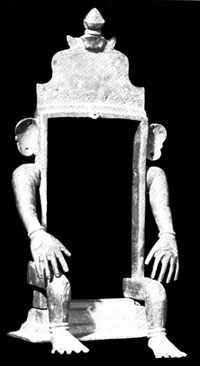
What is a mirror? How much does it weigh? How big
is it? How clear is it?
The untouched Mirror
An important characteristic of a mirror, in this context, is its fundamental
separation from the reflected image. Just as zero remains zero, regardless of
how much it participates in various number sequences, the mirror remains
untouched by the content it reflects. Figuratively speaking, the mirror is the
'nothing' that can reflect everything. Thus, the mirror is my second choice of
metaphors for consciousness.
Both consciousness and the mirror are, in themselves, pure potential and
therefore empty.
Consciousness, like the mirror, is not part of the observed world.
In this sense, consciousness is as empathetic as a mirror.
A mirror is a mirror is a mirror... Consciousness is consciousness is
consciousness.
The reflecting consciousness is the world's witness.
When
Sufis employ the mirror to illustrate the reflection of divinity in humans, they
pay attention to the mirror's condition as well:
"Do you not know why your mirror does not glitter?
Because the rust is not cleansed from its surface"
Rumi
A fascinating aspect of Consciousness is that despite being obscured by veils,
it can vary in intensity and clarity, much like Rumi's mirror.
The Mirror, the Eye, and the Light
In the light of the mirror of you,
the universe observing itself through consciousness.
Roger Penrose
We are the mirror, as well as the face in it.
Rumi
Through the human being, the Universe is making a mirror
to observe itself.
Bohm

The Mirror of the Soul
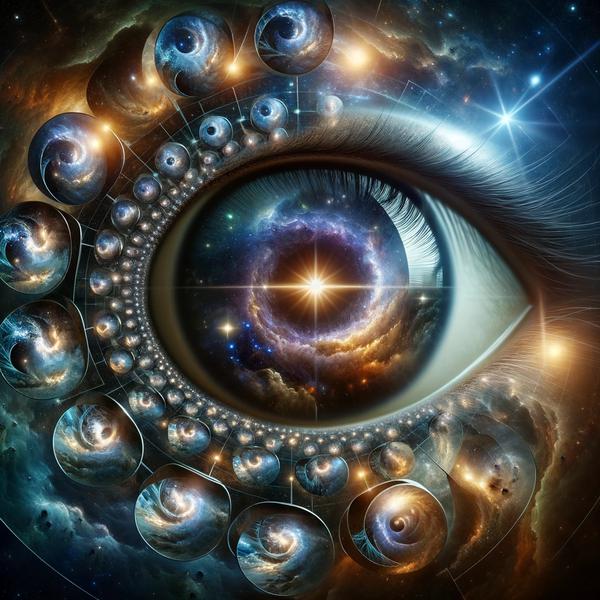
The Eye: Soul's Mirror
The eye is often referred to as the mirror of the soul. It's apparent that
both the mirror and the eye are mediums that unfold in light. My third choice of
wavering metaphors for consciousness is light.
Meditative Experiences in Light
The term "enlightenment" is frequently used to describe the spiritual
liberation of consciousness. According to meditative traditions, we become
enlightened after many years of meditation. There's hardly a serious meditator
who hasn't experienced some form of inner light at some point.
To be enlightened, in my understanding, is to be in an intensified state of
consciousness where one is extremely awake. Wakefulness is a phenomenon
connected to light in more than one sense. We sleep in the darkness of night and
rise with the sun's light, being wide awake during the day. In the chapter on
"Super-Wakefulness," I describe how the intensity and clarity of consciousness
go hand in hand with light.
The Sacred Light
The association between soul and light can be found in both Greek and Indian
antiquity. Light is the most widely used metaphor for the divine from East to
West. In various religious traditions, holiness is iconographically represented
by a halo of light around the head. For Plato, the head was the most divine part
of the human body. Plato's argument for the head's sacredness is that it is the
part of the body closest to heaven. Logos first manifests in the head and then
acts rationally through the body and limbs. For Plato, our reason in the form of
logos is sacred. Buddhism also employed reason in its service. In other words,
reason hasn't always been on a collision course with spiritual pursuits.
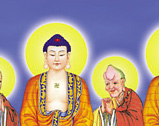
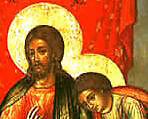
Hellige hoveder - Bevidsthedens ikonografi
fra øst til vest
udtrykt i en nimbus af lys.
The Logical Light
Aristotle describes that there is a glorious light in the soul, through
which we perceive things and distinguish between what is right and wrong. Here,
the light of consciousness is linked to our cognitive and ethical abilities. It
is the light that guides us on the right path to insight.
There are numerous examples. The Enlightenment in the 18th century celebrated
human reason. A century later, the Danish author, Grundtvig, equated light with
knowledge in his poem: "Is the light only for the learned?"
In our language, knowing is connected to light. We perceive knowledge.
Consciousness knows. In this context, note the syllable 'vid' in the word
'consciousness', an Indo-European Sanskrit word that refers to knowing.
Consciousness perceives knowledge.
To perceive is synonymous with looking in, or seeing within. The conscious mind
that knows uses light as its recognizing medium. It should now be crystal clear
or, at the very least, dawn on us.
Understanding and Distance
In Eckhart's world, understanding equals separation:
The more we can impute to Him
(God) not-likeness,
the nearer do we get to understanding Him.
Light can transmit information over vast
distances. However, you cannot see yourself clearly when your nose touches the
mirror. Light requires distance.
Consciousness unfolds in distance, in space. Attention understood as awareness
on the other hand, is distanceless.
In this sense, we both behold and touch the world:
Oh, invisible world, we behold you.
Oh, invisible world, we touch you.
Francis Thomson
To become capable of perceiving something, one
must have it at a remote sensory distance. Cognition, like light, requires
distance. What is too close cannot be perceived.
Therefore, the hardest thing is to see oneself.
For we are distanceless in relation to ourselves. What we can see is what is
outside and different from ourselves. We need to experience things at a distance
to process them cognitively. Our fundamental identity, invisible to ourselves,
is so close to us that there is no room to see it... We are it and therefore see
others best.
Kabir says that we are like fish in a lake, thirsting for water. In other words,
Meister Eckhart says the same - that we do not understand God when we are with
Him. Only when we are separated from Him can we understand Him. Eckhart even
goes a step further and claims that understanding and God never meet.
If I had a God I could understand, He would no
longer be my God.
Meister Eckhart
The paradox is that the sacred light, as God's messenger, kills Him.
The Devilish Light
Light is the bridge that connects the incomprehensible primordial ground
with our known world in time and numbers.
This spirit knows neither time nor numbers.
Numbers do not exist except in the tragedy of time.
Meister Eckhart
Only in the collision with the time-space 'number
tragedy' does light-consciousness arise. Light presupposes and spreads in time
and space. In this sense, light is a created phenomenon. Light is something that
can be measured and understood scientifically, as is done in Einstein's famous
equation E=MC2, where it, as the fastest measurable phenomenon, is located at
the outermost boundary surfaces of our space-time reality.
In a psycho-mythological sense, light, helios, is the most sacred thing in the
'tragedy of time'. Insight comes with light, but not without a price to pay.
Light exists in the duality of space-time. Light does not belong to the non-dual
dimension of the mirror but is the dual prerequisite for objects to interact
with the mirror: For without light, there is no reflection. Consciousness is,
therefore, a term translated to space-time for the absolutely incomprehensibly
incomprehensible primordial ground. The non-dual primordial ground cannot be
described as consciousness in itself.
The abstract materiality of light is the
very prerequisite for it to interact with the mirror. The same applies to the
'soul'. Here, the reflective surface of consciousness stands on the boundary
between time and space and the nothingness that transcendentally stands
'outside'. The soul's light, in this sense, is something that interacts with
nothingness in the empty plane of the mirror.
Light comes from the world and returns to the world in a feedback loop after
encountering the mirror's nothingness.
In the reflected light, we realize our thoughts. We also listen to them, but
that's another story.
The Lightbringer
It therefore makes perfect sense that it is Lucifer, the lightbringer, who
represents light. Light requires duality, the separation of objects in time and
space. This separation is equivalent to hell, light, and knowledge. The serpent
in the Old Testament's Fall offers us knowledge. Seen through the reflections of
these metaphors, light is the first fall from unity to duality.
Deep in the etymological wisdom embedded in language, we find words for 'two' in
the company of many of the world's calamities. A conflict can be derived from
the number two. Doubt and opposition, the same. Dystopia is the opposite of
utopian. Dysfunctional, dystrophy, disharmony, dissonant,
Translated into numbers, it makes sense to metaphorically depict the
incomprehensible primordial ground as 'nothing' to the left of 'zero', after
which light-consciousness enters the world between zero and the number one,
which represents unity. However, light, like the number one, is right next to
both zero and the rest of the fateful series of numbers that lead into the
tragedy of time. Nothing is therefore as close to non-duality as unity. Light
creates the first osmotic dance with the incomprehensible consciousness. The
non-dual timelessness of consciousness is translated here into eternity.
Eternity is indeed a measurable unit, but so extreme that in relation to the
numbers found in our bank accounts, it becomes 'religious', as C.G. Jung pointed
out. The incomprehensible non-location of consciousness is similarly translated
into infinity. All emotions, concepts, and series of numbers that tend toward
infinity are perceived religiously in the human psyche, according to Jung.
Eternity and infinity are the light and space-time versions of the primordial
ground's incomprehensible abundance in light, time, and location. The primordial
ground is therefore much closer to darkness than light.
Between Light and Sound
As we know, light appears both in wave form and particle form. In its
particle form, light is closely related to the material world of space-time.
Manifested in its wave form, it is abstract, like vibration, and closer to the
aspect of nothingness represented by zero. In this aspect, sound is a better
metaphor than light. Before light came the word, as in the Indian AUM and in the
Bible: "In the beginning was the Word, and the Word was with God."
Consciousness: 'contamination' through light and sound
While consciousness in itself, like the mirror, is free from what is
reflected, consciousness in its encounter with time and space is almost
impossible to distinguish from the media with which it interacts with the world.
It is therefore no wonder that even the latest research struggles to make sense
of the nature of consciousness without simultaneously objectifying it as an
observable phenomenon, which it is not. In my own analysis of the nature of
consciousness, I have, as the attentive reader may have already noticed,
'committed' this conflation. The only difference might be that I am
meta-conscious of this Gordian knot that cannot be cut in time and space.
The primary messengers and accomplices of consciousness are light and sound. In
light and sound, we realize with heard words. In this sense, consciousness
contains both God and the devil within it. However, as the title polemically
suggests, it is not consciousness itself that is contaminated. Instead, it is
the 'self' that, in the play between light and sound, cannot see the mirror
within itself but constantly chases reflections.
Carbon based life versus silicon or other life forms
As organic torchbearers of the light of consciousness, we might soon be
surpassed by systems far more complex than our brains: quantum computers
connected to the internet, which has grown large and complex enough to deserve
the designation of our planet's neural network. Let's enjoy it while it lasts.
As carbon-based life, we hold the baton right now, but we may soon hand it over to our silicon
cousins when their systems awaken in a self-referential complexity that
surpasses our own. Our silicon relatives also have the advantage of being far
more resistant to environmental factors like pollution.
As humans, we might only be significant as torchbearers for Prometheus' fire.
As humans, we are mortal, but as consciousness, we stand on the border between
time and space in a vast, deep, and mysterious universe that currently looks at
itself through our eyes but may prefer a webcam in the not-too-distant future.
CONSCIOUSNESS IN THE COLLISION ZONE BETWEEN
DIMENSIONS
Throughout history, humans have understood and communicated their inner
experiences through the collective language filters of their time. No one can
jump over their own shadow - not even a mystic who, like me, knows that I am
God. (You are too!)
Therefore, the worldview of the Bible's patriarchs fits a life around 700 BC in
the Middle East, and the Quran's military expansion makes sense in the context
of desert life around 700 AD.
When the steam engine was invented, it made sense to view humans as machines
under full steam. Even a hundred years later, Freud's terminology hints at
metaphors from a steam engine, with constant overpressure on the subconscious
boiler.
We continually create metaphors based on the collective knowledge of our time.
The problem arises when these metaphors become outdated and can no longer sync
with the new knowledge and social metabolism of a new era.
Inspired by my timeless mystical friends from both the East and the West,
I have dared to introduce an impossible capture of ding an sich that is prior to
consciousness. Brahma-consciousness is the most incomprehensible aspect of time and
space. In contrast, the primordial abyss is the most incomprehensibly
incomprehensible aspect beyond time and space.
e a new framework for understanding
consciousness that, whether true or false, will likely be as outdated in a
thousand years as the Old Testament's patriarchal tribute to the goodness of
keeping slaves is today. With fresh imagery, I will try to imagine myself a
little further beyond the cliffs of the primordial abyss.
Historically, we have repeatedly underestimated the world we live in. We used to
think that the Earth was flat. Then we discovered the solar system and later the
galaxies. Today, we talk about the existence of parallel universes. The latest
cosmology even divides these parallel universes into two types, namely Type 1
and Type 2.
Type 1 universes are similar to ours. However, they are moving away from our
universe so quickly that we will never be able to receive information from them
in the form of light. These universes will likely be subject to the same
approximately 200 cosmological constants as our 'known' universe.
Type 2 universes/dimensions are different. They exist not separated by distance
but parallel to our known universe. According to these theories, there would be
an infinite number of such parallel universes. Unlike Type 1 universes, they
would not be subject to the same cosmological constants in any way. We could
easily imagine a universe or dimension without space-time.
In this context, I envision consciousness as a time-space 'copy' of the absolute
space-timeless primordial abyss. Atma-consciousness is the 'translation' of the
primordial abyss that occurs in the human brain when two parallel dimensions
with vastly different cosmological constants collide.
From this perspective, any form of biological life is built around a collision
point between an ultra-foreign dimension and our known dimension in time and space.
The membrane between the two dimensions is the human consciousness soap bubble
mirror.
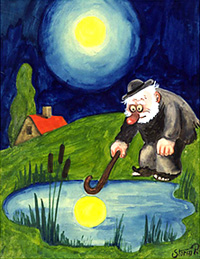
This collision occurs through every eye that sees. For here, consciousness
arises in countless fractal repetitions from the infinitely large to the
infinitely small. The silent witness who perceives the world through the eye's
portal is created when the unfathomable primordial abyss collides with our world
of luminous space-time.
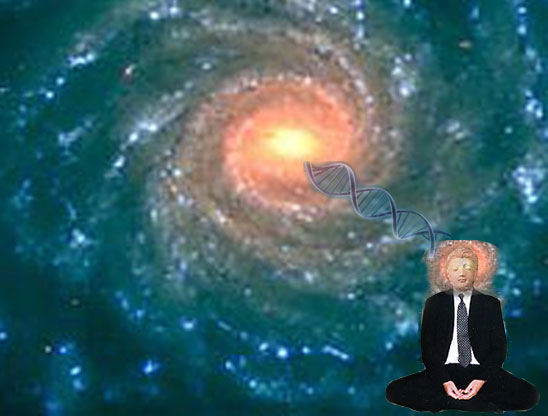
Consciousness arises in the contrast between the
two dimensions that, so to speak, penetrate each other. Nietzsche's famous
words, When you gaze long into
an abyss, the abyss also gazes into you, make perfect sense here.
The notion of God is the personalized soap bubble consciousness's projective
understanding of the absolutely incomprehensibly incomprehensible primordial
mystery. All gods and religious concepts ever mentioned cannot be anything else
than our, in time, space and culture made projection fields of this super
glorious mystery.
This mystery is reaching beyond the rules of our universe set by the
cosmological constants and will therefore never, I repeat never, be grasped.
What can be grasped, albeit the most difficult of all to understand, is the
birth of this primordial abyss into our universe.

In this birth, we create the primordial abyss in our own image simultaneously
with the primordial abyss creating itself personified in us in precisely the
same image.
In this biocentric retrocausality, the Son
of Man is born as a simulation of the primordial abyss into the luminous
space-time continuum. Nothing in our time-space dimension resembles the
space-timeless primordial abyss more than human consciousness/soul.
In this light, consciousness is a simulation of the alien dimension knocking on
the half-open door leading into time and space. Here, the primordial abyss gives
birth to God, who gives birth to us. The following description is my impossible
attempt to articulate such a collision with words. I don't fully understand them
myself and will periodically return to this section and rewrite it.
At the moment of collision: An infinitely small asymmetry in the primordial
abyss's nothingness. This asymmetry creates, like a speck of dust in God's
omnipresent emptiness, reflecting eyes in time and space. These eyes are your
eyes and mine.
Without error, no mirror. Humanity is a sacred mathematical 'error'.
Through this 'rift', the pure potential of emptiness is released in its first
manifestation: the invisible mirror. The tear in the emptiness of time-and-space
weaves the mirror of consciousness as a tabula rasa beyond the world of the
mind.
This anomaly manifests the world in the same way a pen writes an entire book or
a grain of salt causes a glass of saltwater to crystallize.
The mirror of emptiness holds the fullness of the world, just as the whiteness
of paper holds letters and the cinema screen shows films of all kinds.
'First' there was nothing. Then there was the mirror: an invisible interface
between existence and non-existence. In the mirror, something is reflected in
something as a process in time and space. In the mirror, this 'nothing' now
interacts with 'things'. The mirror is the reflection of things in nothingness.
The mirror of consciousness grows in time and space in pace with the world's
self-referential complexity. The mirror of consciousness is here a living and
fluid 'nothing'. Beyond time and space, the mirror of consciousness is an
unchangeable zero.
Without the perfect imperfection of the speck of dust, no biological life would
exist. For the reflective life grows at the interface between the worlds of dogs
and cats.
In conclusion, consciousness dances as an enigmatic riddle, slipping through the
grasp of our understanding and defying the constraints of language and science.
This captivating force weaves us into the fabric of the cosmos, reflecting the
divine spark within us. As we set sail on the thrilling odyssey of unraveling
the secrets of consciousness, we must dare to embrace the paradoxes entwined
with light, sound, and duality. By delving into the rich tapestry of metaphors
and perspectives, we start to fathom the mesmerizing complexity and vibrancy of
consciousness and its pivotal role in our existence. It is through this
exhilarating quest that we might unveil the hidden treasures of our being and,
perhaps, retrace our steps back to the boundless, primordial source from which
we all emerged.
In the coming chapters we will dissect and discus more footprints made by the
invisible thief.
●
IV.Super Consciousness - the Holy
Grail
|










